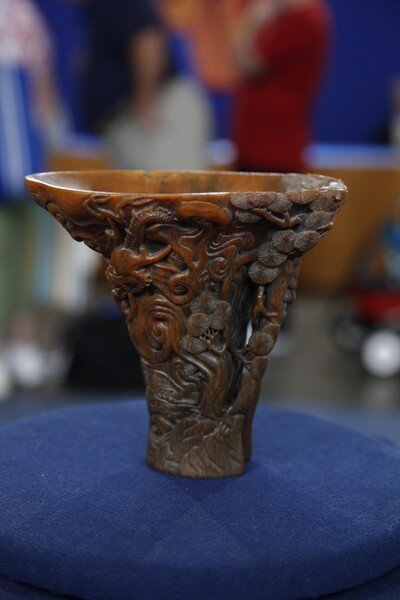17th-Century Chinese Rhinoceros Horn Cup
ANTIQUES ROADSHOW APPRAISAL
On this episode of Antiques Roadshow Lark E. Mason appraised a 17th-Century Chinese Rhinoceros Horn Cup.
APPRAISED VALUE (2011) | $350,000 Auction – $450,000 Auction
This appraisal was featured in Pittsburgh, Hour 1 (#1607) and was filmed in Pittsburgh, PA on August 13, 2011.
APPRAISAL TRANSCRIPT
GUEST:
My husband's had it for about 30 years or so. My understanding is a rhino horn cup. Real or fake, we... That's why we're here, to find out. My husband got it in New Jersey at a flea market for a dollar in about 1976.
APPRAISER:
You have an idea of the value, you think, if it's real?
GUEST:
About ten years ago, we kind of looked into it and we were thinking maybe at the time around $30,000.
APPRAISER:
Okay. It's nice and big. It's very large, and it certainly conforms to the shape of a rhinoceros horn. And this particular material is very wonderful to carve. It produces not only a crisp kind of image, a very sculptural image, but it also combines that with a great color, this kind of golden-hued color. So that's one of the things that appeals to people about these horns. So as we look at this particular one, the iconography of this is we have a dragon here at the upper side, and if you follow it all the way down, you see that it's emerging from rock work and turbulent waves and kind of vapors, right down here at the base. And then over to the side, you notice that there's a pine, and a pine branch goes on up the side and it curls over the top and the kind of gnarled branches. And the pine is one of the images that in China we call one of the three friends of winter, and it's symbolic of longevity. The dragon symbolizes power and was always associated with the imperial household in China. So, these are things that give us some indication of what kind of audience he was intending this to go to. So it was probably for a male audience. For somebody who had some money, who was a wealthy person. Certainly they did make copies of these and they made these throughout the 19th century, so a lot depends on the age as to the value. So, one of the things that we want to look at is-- we turn this around-- is the way that the carving is done, and you see right here there's a lot of movement in the carving here, as you look at the clouds that kind of trail up the side, and that shows that whoever did this had some degree of skill. On the other hand, if you look down at the bottom, you'll see there's kind of this etched design that's down here at the base and on the surface of the dragon's body. It's not as well done as I would like to see. So, it's not an A-plus example of the top skill that you would see with a carver. You can see more clearly here how the pine trails up the edge, there's kind of these gnarled branches, with these stylized pine needles and circles. The condition is pretty good. There's one chip, which is very visible here at the edge, but other than that, it's in pretty good shape. I do believe that it is early, carved in the 17th century. I believe it's authentic. I don't believe it's a copy.
GUEST:
Okay.
APPRAISER:
So those are good things.
GUEST:
Very good.
APPRAISER:
So, do you have any idea what I think it's going to be worth?
GUEST:
No idea.
APPRAISER:
How about $350,000 to $450,000?
GUEST:
Wow, wow. I didn't expect it to be worth that much. (sniffles) That's amazing, I'm speechless. (laughs) What was the value again? I think I zoned out there for a second.
APPRAISER:
Um... $350,000 to $450,000 at auction is what I would expect it to sell for, and I would have to say that may even be a bit on the conservative side.
GUEST:
(sighs) I think my heart about fell... out of my seat.

